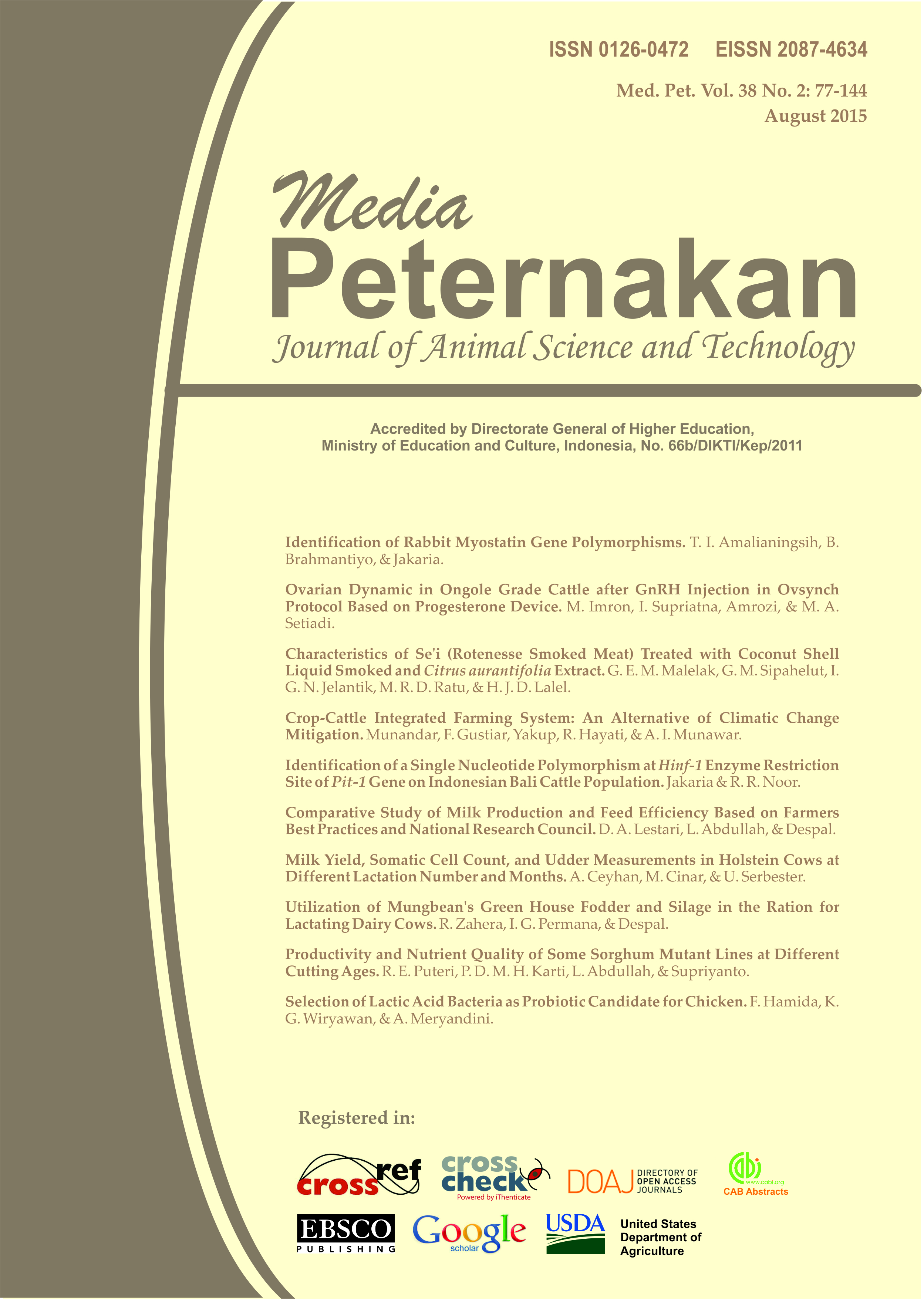Productivity and Nutrient Quality of Some Sorghum Mutant Lines at Different Cutting Ages
Abstract
The objective of the study was to explore the appropriate cutting age to produce optimal biomass and good nutrient quality from sorghum mutant lines BMR i.e., PATIR 3.5 M7, PATIR 3.6 M7, and PATIR 3.7 M7, also SAMURAI I (M17). A completely randomized in Split Plot design with 2 factors and 3 replicates was used. The first factor was the type of sorghum (SAMURAI I M17, PATIR 3.5, PATIR 3.6, PATIR 3.7) as the main plot and the second factor was the cutting age (85, 95, 105) as a subplot. Parameters observed were the production of stems, leaves, grains, total biomass production, ash, crude fat, crude fiber, crude protein, NFE, TDN, percentage of DMD, OMD and N-NH3. Data were analyzed by using ANOVA followed by DMRT (Duncan Multiple Range Test). The results showed that there were highly significant interactions (P<0.01) between cutting age and type of sorghum in production of stems, leaves, grains, total biomass production, value of TDN, DMD, OMD, and N-NH3. Increasing cutting age significantly increased the percentage of ash content, crude protein and crude fat. The sorghum type significantly affected crude fat content nonBMR sorghum variety of SAMURAI I (M17) and achieved optimal biomass production and nutrient content at cutting age of 85 d similar to BMR sorghum mutant lines PATIR 3.6 and PATIR 3.5, whereas BMR sorghum mutant lines of PATIR 3.7 achieved optimum production at the age of 95 d of cutting. All types of sorghum varieties was not recommended to be harvested at 105 d. Biomass production increased with the increasing of cutting age, but the nutrient content decreased.
Key words: cutting age, mutant, sorghum
Downloads
References
[AOAC] Association of Official Analytical Chemists. 2005. Official Methods of Analysis of AOAC International. 18th ed. Assoc. Off. Anal. Chem.,Arlington.
Colombo D, Crovetto Gm, Colombini S, Galassi G, Rapetti L. 2007. Nutritive value of different hybrids of sorghum forage determined in vitro. Ital.J.Anim.Sci. 6(1): 289-291.
Dann HM, Grant RJ, Cotanch KW, Thomas ED, Ballard CS, and Rice R. 2008. Comparison of brown midrib sorghum-sudanggrass with corn silage on lactational performances and nutrient digestibility in Holstein dairy cows. J. Dairy.Sci. 91: 663-672.
Godoy JGV, Tesso TT. 2013. Analysis of Juice Yield, Sugar Content, and Biomass Accumulation in Sorghum. J. Crop Science. 53(4) : 1288-1297.
Jayanegara A, Sofyan A, Makkar HPS, Becker K. 2009. Kinetika produksi gas, kecernaan bahan organik dan produksi gas metana In Vitro pada hay dan jerami yang disuplementasi hijauan mengandung tanin. Media Peternakan.32(2):120-129.
Mansyur HD, Dhalika T, Hardjosoewignyo, Abdullah L. 2005. Pengaruh interval pemotongan dan invasi gulma Choromolaena odorata terhadap produksi dan kualitas rumput Brachiaria humidicola. Media Peternakan.28(2):77-86.
Nabi C G, Muhammad Riaz, Ghulam Ahmad. 2006. Comparison of Some Advances Lines of Sorghum Bicolor L. Monech For Green Fodder/Dry Matter Yields and Morpho-Economic Parameters. J.Agric.Res. 44(3).
Oliver AL, Grant RJ, Pedersen JF, O’rear J. 2004. Comparison of brown midrib-6 and -18 forage sorgum with conventional sorghum and corn silage in diets of lactating dairy cows. J.Dairy Sci. 87:637-644.
Oliver AL, Pedersen JF, Grant RJ, Klopfenstein TJ. 2005. Comparative effects of the sorghum bmr-6 and bmr-12 genes: I. Forage sorghum yield and quality. J. Crop.Sci. 45: 2234-2239.
Tilley JMA, Terry RA. 1963. A two stage technique for the in vitro digestion of forage crops. J. Br. Grassland Soc. 18 : 104 – 111.
Vasilakoglou I, Dhima K, Karagiannidis N, Gatsis T. 2011. Sweet sorghum productivity for biofuels under increased soil salinity and reduced irrigation. Field Crops Research. 120: 38-46.
Vogler RK, Tesso TT, Johnson KD, Ejeta G. 2009. The effect of allelic variation on forage quality of brown midrib sorghum mutants with reduced caffeic acid O-methyl transferase activity. African J. Biochemistry research 3(3):070-076.



